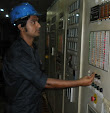Fuel System
The function of the fuel system is to store and supply fuel to the cylinder chamber where it can be mixed with air, vaporized, and burned to produce energy. A fuel pump draws the fuel from the tank through fuel lines and delivers it through a fuel filter to fuel injector, then delivered to the cylinder chamber for combustion.
General Flow Chart
Component used in fuel system
· HFO main storage tank
· HFO secondary storage tank
· HFO purifier
· HFO duplex filter
· HFO day tank
· HFO viscosity module
· Fuel pump
· Fuel injector
Main Storage Tank
Main and secondary fuel tank used to store fuel from shipment.Steam circulates around the tank to keep the temperature around 50 degree celcius.
HFO Purifier (How it works?)
Usually rotary or centrifugal type purifier used. It separate water and solid sludge(usually Carbon deposit,Sulfur,ash etc).It is important that the separators be correctly adjusted for the specific gravity of the fuel.
All fuel oil separators available should be operated continuously. Fuel flow rate and temperature control also are important. Experience has shown that the correct temperature for centrifuging high viscosity fuels is in the region of 95 to 98 degrees Centigrade. If excessive sludging should occur, giving evidence of incompatibility, the fuel should be separated at the slowest possible rate using purifiers in parallel. When drawing from a fuel tank for the first time, it is very important that a careful watch be kept on the purifier for the first twelve (12) hours of separation. When starting a separator, the fuel oil discharge should be returned to the settling tank until stable efficient operation has been confirmed. Then it is safe to reroute the fuel oil to the service tank. For most operating situations, series separation is recommended. The purifier backed up by the clarifier offers the best operation from a water, sediment and sludge removal, and safety of operation viewpoint. If the specific gravity of the fuel oil exceeds 0.991, the purifier should be reconfigured as a clarifier and the shoot or sludge discharge cycle decreased to between five (5) and twenty (20) minutes. Fuel oil flow through a separator can best be controlled by a variable speed motor fitted on the feed pump supplying the separator. This method is highly recommended over throttling a single speed feed pump. The approach minimizes formation of troublesome third phase, water-in-oil emulsions that require extra maintenance to manually clean the separator.
After purifying the fuel filtrate by HFO duplex filter. Then store in service or day tank.
Service Tank/Day tank
To ensure fuel feed to the main engine, the separated heavy fuel oil (HFO) is pumped into the service tank (day tank. Heating coils in both tanks ensure an even temperature between 167°F and 194°F (75°C and 90°C), which keeps the oil pumpable.
Viscosity Module (How it works?)
The fuel comes from day tank have a high viscosity. To inject the fuel in the cylinder need viscosity same as diesel. So there is a arrangement in viscosity module to reduce the viscosity in particular value by heating fuel(generally by steam).
Fuel Pump
A plunger type high-pressure fuel pump includes a plunger reciprocated in a cylinder. A fluid pressurizing chamber of the pump has a chamber with a capacity that changes with reciprocation of the plunger.
Fuel Injector
Fuel injector used to inject fuel into the combustion chamber. It measures the fuel, atomized, vaporized the fuel and mixed with compressed air. Fuel pump deliver fuel to the injector at high pressure. The needle lifted when the pressure reaches at 320 bars and spray occur.









